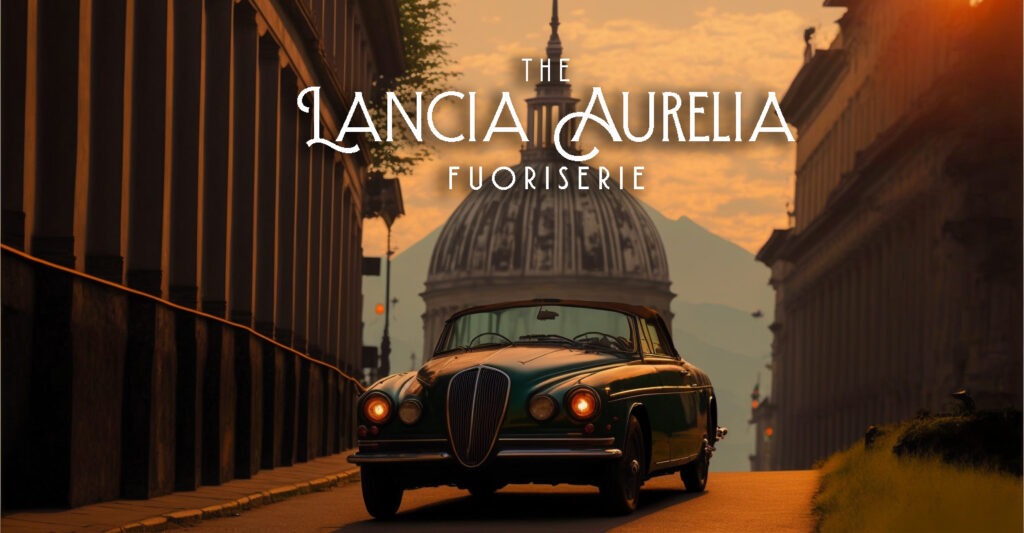
The Lancia Aurelia chassis history
From the moment the Lancia Aurelia was unveiled to the public at the Turin Motor Show in April 1950, Lancia put a coachbuilder’s chassis under construction alongside the classic saloon (B10). According to the Turin company’s forecasts, production of this chassis – named B50 (B51 in the version to accommodate heavier bodies) – should reach at least a thousand units. Despite Lancia’s fortunate commercial move, which included three Lancia Aurelia Fuoriserie versions with special bodywork in its price list (the Pininfarina cabriolet and the Stabilimenti Farina coupé both on the B50 chassis and the Viotti ‘Giardinetta’ on the sturdier B51 floorpan), demand, while not despicable, did not live up to expectations. The reasons are to be found in the unexceptional performance (due to the underpowered 1.8-litre engine in relation to the weight) and the very high prices with which these cars face the market (which start at 2.5 million for the Viotti ‘Giardinetta’ but reach as much as 4 million in the ‘fuoriserie’ versions with luxury finishes made by various coachbuilders).
It should be noted that, in addition to the Viotti ‘Giardinetta’, two other Lancia Aurelia Fuoriserie ‘station wagons’ were built – again on the B51 chassis: one in 1950, by Frua and a second in 1951, built by the Monterosa coachbuilder. After the production of 584 chassis (485 ‘B50s’ and 99 ‘B51s’), in 1952 – perhaps a little late – the chassis were fitted with the 2-litre engine that delivered around 70 HP and took on new names (B52 for the normal chassis, B53 for the heavier bodies), but by this time the sector was overcrowded and production numbers were very limited: 184 units (98 B52s and 86 B53s).
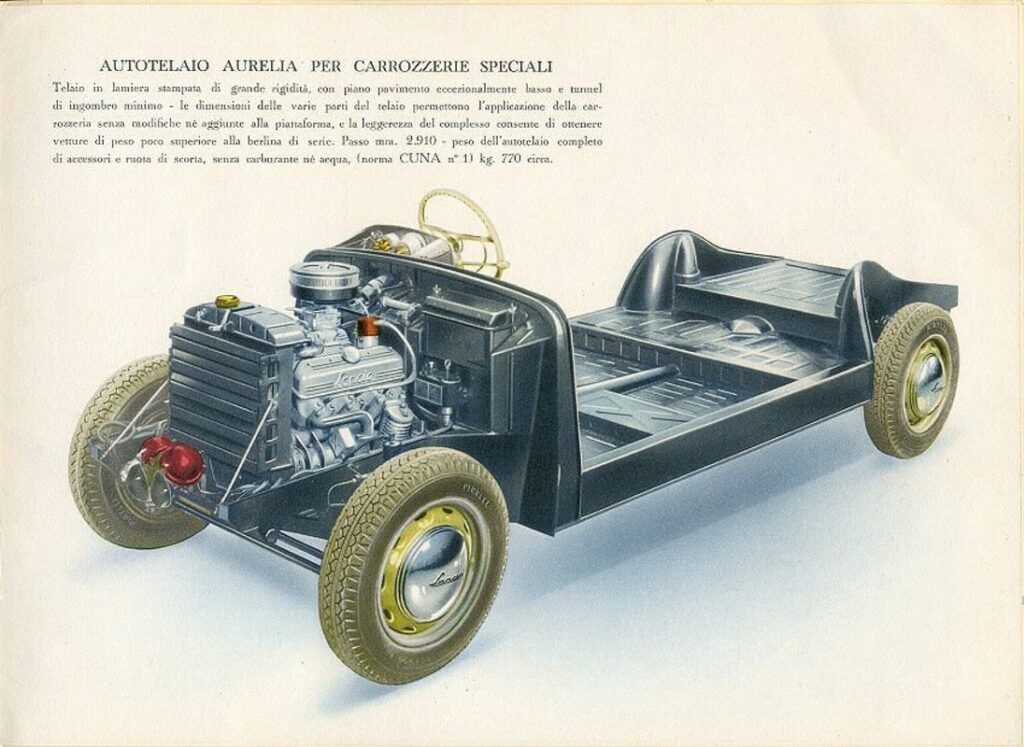
In 1954, with the release of the ‘second series’ of the Aurelia with its 2.3-litre engine, the sale of the chassis came to an end. Fourteen were still produced in 1955/56 (called B55 and B56, with the suffix ‘S’ for left-hand drive), but these were either for internal use or bodied as one-offs almost exclusively by Pininfarina, such as the famous ‘Florida’ series. For completeness of information, it should also be mentioned that in 1953 a special B60S chassis was also built, fitted with a B20 type engine and intended for a special car for the State Police. Altogether, therefore, the Aurelia chassis built between 1950 and 1956 reached 783 units.
Aurelia B50-B51
At the same time as the B10 saloon, ‘naked’ coachbuilder chassis for Lancia Aurelia Fuoriserie came onto the market in two slightly different versions: the B50, which we would describe as ‘normal’, and the B51, which was more suited to accommodate heavier bodies. The differences are minimal: the B51 mounts larger tyres and a ‘shorter’ axle ratio. Otherwise, the two chassis are identical and mount the B10’s 1.8-litre engine.
It should be noted that Pininfarina, Stabilimenti Farina and Viotti put into production – albeit in limited quantities – the respective Cabriolet, Coupé and Giardinetta (Station Wagon) versions, which Lancia included in its official price list. The Cabriolet and Coupé are built on the B50 chassis, while Viotti’s Stationwagon is built on the B51. At the end of the day, very few Coupés were built at Stabilimenti Farina, while production of Cabriolets and Giardinettas was more substantial: Pininfarina built just under three hundred cabriolets (265 ‘normal’ and twenty or so in ‘special layout’), while Viotti’s Giardinettas numbered close to fifty (47 or 48 according to sources). The other B50 chassis were used by almost all the major Italian coachbuilders (Allemano, Balbo, Boneschi, Canta, Ghia, Pininfarina, Stabilimenti Farina, Vignale) to make their custom-built cars, while the remaining B51 chassis served as the basis for the saloons made by Boneschi, Frua, Ghia, Pininfarina and a small number of giardinettas made by the Monterosa coachbuilder.
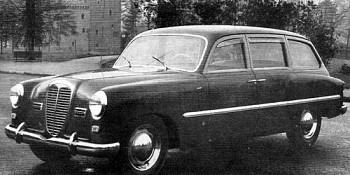
During production, there was only one major change: the increase in the compression ratio from 6.85:1 to 7.00:1.
The success of these Lancia Aurelia Fuoriserie chassis is good but not exceptional: the relatively modest engine power (which penalises performance) and the prices charged by coachbuilders, which are rather high and in some cases reach costs that are double of the standard saloon, have held back their spread.
Aurelia B52-B53
In 1952, perhaps a little belatedly, Lancia fitted the Aurelia chassis to be supplied to coachbuilders with the more powerful 2-litre engine already adopted on the B21 saloon. The new chassis, thus equipped, were named B52 and B53: the B52 replaced the B50 and was the normal chassis, while the B53 replaced the B51 and was the one intended for the bulkier and heavier bodies.
These two-litre engine chassis – the production of which did not even reach 200 units – were used, like their predecessors, by the most renowned Italian coachbuilders and also by some foreign coachbuilders (such as the Swiss Beutler and Worblaufen). On the B52 chassis, Pininfarina built, among others, almost all of the famous PF200s, while the 1952 Vignale coupé designed by Giovanni Michelotti (and built in several, even slightly different, examples), and the Ghia-Boano Junior, a coupé that came in two versions, are worth mentioning: the first, of 1952, rather conventional, and the ‘Boano-Junior 2’ of the following year, which instead caused a sensation due to the boldness of its line (of the front in particular). It should be noted that this last ‘Junior’, built by Ghia, was also the design of Gian Paolo Boano, the son of Felice Mario Boano. Father and son, ousted from Ghia in 1953, opened their own coachworks the following year. The B53 chassis – on which Viotti still built a few “giardinettas” and which other coachbuilders used for larger cars – was also used for the proposal of a military torpedo that the Italian Army rejected in favour of the corresponding model on an Alfa Romeo 1900 chassis.
Aurelia B60S
It is reported that in 1953, Lancia built a single speciment numbered B60S-1001, a special chassis with independent four-wheel suspension (therefore similar to the B52), fitted with a B20 type engine (whose displacement cannot be defined with certainty, which was probably 2 litres but theoretically could also have been 2.5 litres). This chassis appears to have been intended for a special police car, built to ministerial specifications.
A car built on the bodywork of the Aurelia berlina (type B21/B22) was in the Italian State Police force at the time. A picture of this car appears on page 17 of issue 31 (year 1990) of the Italian magazine ‘Ruoteclassiche’. Of course it is not certain that this berlina corresponds to the B60S chassis.
Aurelia B55-B55S-B56-B56S
In 1954, when the ‘second series’ of the Aurelia saloon with the 2.3-litre engine came out, construction of the chassis (B52, B53) for the coachbuilders ended. In the following two years (1955-56), however, according to Lancia’s production records, 14 chassis with the 2266 cm³ engine were still being built. This very limited production is marked by the initials B55 and B56, which, as in the case of the earlier B52 and B53, identify two chassis differing from each other only in the value of the axle ratio adopted. Basically, these B55 and B56 chassis (B55S and B56S if left hand drive) are used for “internal use” by the company or as the basis for some very special Pininfarina creations: a B55 chassis (with a shortened wheelbase) that gives rise to the last coupé of the PF200 series, a B56 chassis that is bodied as a limousine, plus 4 or 5 B56 chassis that house the bodies of the “Florida” series. It should be noted that two chassis from this series were also sold to Ghia, which made a coupé and a limousine. The one-off ‘Florida 2’ released in autumn of 1957, Battista Farina’s personal car, was instead built on the first Flaminia-type chassis.
Pininfarina's Cabriolet
The first (together with Stabilimenti Farina and Carrozzeria Viotti) to use the B50 chassis, Pininfarina already exhibited its ‘cabriolet’ at the Turin Motor Show in May 1950. This beautiful and harmonious creation by the already famous coachbuilder from Turin, entered the official Lancia price list, but Pinin Farina reserved the right to built the speciments ‘directly’ with special finishes expressly requested by the customer. And so it will be: many Aurelia B50 Pininfarina cabriolets will have different details to those on the ‘official’ version (more refined interiors, special leather, different instrumentation design, different headlights, additional chrome, electro-hydraulic devices for opening and closing the upholstered soft top, more wraparound bumpers, concealed external handles).
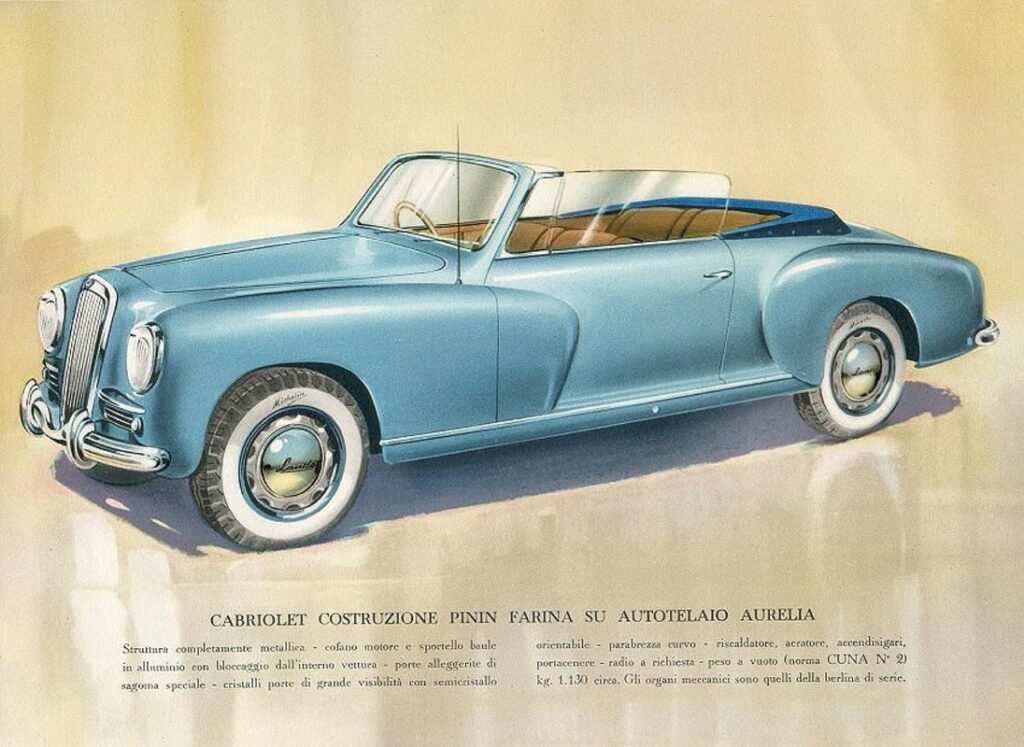
All in all, it seems that Pininfarina built just under three hundred cabriolets: 265 that could be described as ‘normal’ and around twenty with ‘special fittings’. Some of these examples (however a limited number of units) were built on the basis of the B52 chassis with a 2-litre engine released in ’52.
The main technical characteristics of this version are: B10 type engine with a 1755 cm³ displacement and 56 HP power, platform chassis, 291 cm wheelbase, 475 cm length, 165 cm width, 150 cm height, 10.90 m turning circle, 165×400 tyres (inflation pressure 1.50 kg/cm2, both front and rear), weight in running order 1240 kg, maximum speed around 130 km/h. Among the features of this special “almost custom-built” version are the aluminium bonnet and boot lid, lightened doors, curved windscreen, heater, aerator, cigar lighter, ashtray, radio on request: these are features that, however, can also be found on the standard B10 saloon.
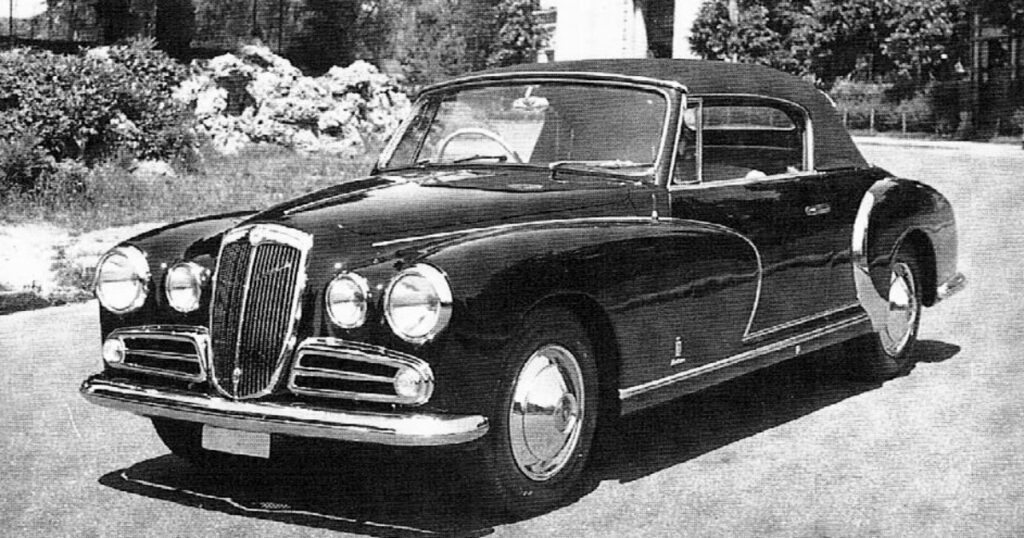
And here we come to the sore point, the prices: the first price list (May 1950) speaks of 2,600,000 Lire, rising to 2,885,000 Lire the following year. But these prices (taken from Lancia’s price list, therefore referring to cars in ‘normal’ trim) rose to over 4 million lire for ‘cabriolets’ in ‘Lusso’ trim (in 1951, for example, a Cabriolet Lusso cost 4,189,000 lire)
The Giardinetta by Viotti
Convinced, not wrongly, that the Aurelia was hardly suited to a ‘station wagon’ bodywork (which at the time was the typical livery of the farmer’s or fruit and vegetable wholesaler’s car), Gianni Lancia ended up acceding to the request from some of the company’s major Italian dealers and allowed the Viotti coachbuilder to make a few dozen ‘station wagons’, even including this special version in the official price list. This ‘station wagon’ was presented shortly after the launch of the first Aurelia, the B10 (which took place in the spring of 1950) and was distinguished by the name ‘giardinetta’, a term ‘invented’ by Vittorino Viotti, who patented it and forced even the mighty Fiat to use the term ‘giardiniera’ to identify the station wagon version of its little 500-Topolino.
Like Pininfarina’s cabriolet and the Stabilimenti Farina coupé, Viotti’s giardinetta was therefore included in Lancia’s official price list, with a price of 2,250,000 lire in 1950, rising to 2,508,000 the following year, when all Italian cars went up in price.
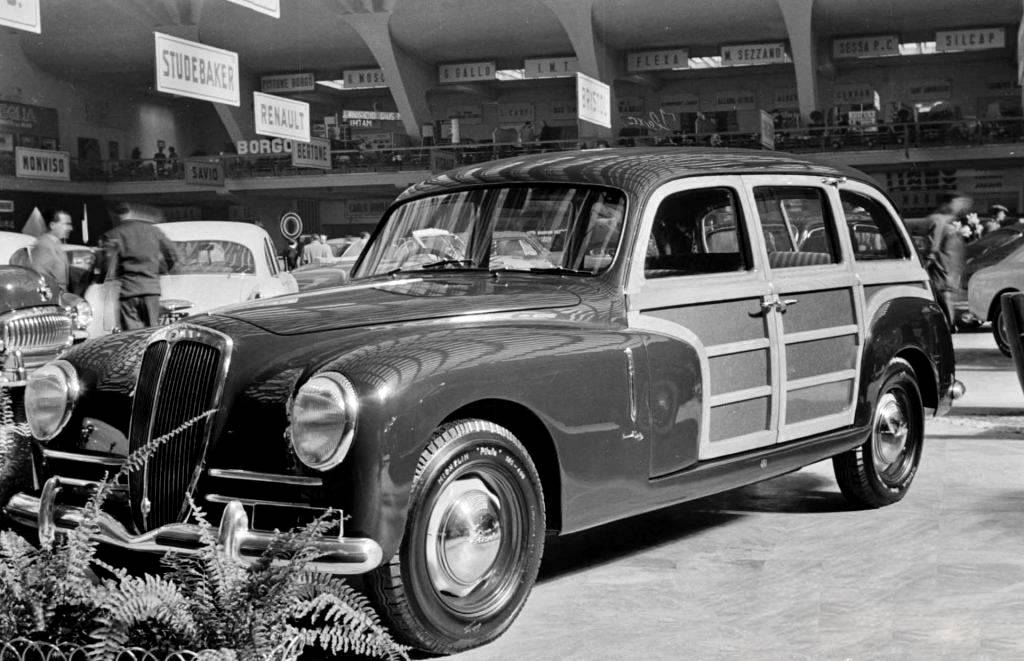
This original creation, which is characterised by the wooden panels on the sides, is mounted on the special B51 chassis that Lancia made available and which substantially differs from the B50 in the adoption of oversized tyres (185×400, with inflation pressures of 1.40 kg/cm2 at the front and 1.60 kg/cm2 at the rear) and a ‘shorter’ axle ratio.
In the three-year period 1950/52, around fifty ‘Giardinettas’ were built, two (or three) of which were on the B53 chassis with 2-litre engines. It should be noted that, of these fifty or so Giardinettas, just over half (around thirty) had wooden panelling covering practically the entire doors, while around twenty had panelling covering only the upper half.
Although it was a model that Lancia itself listed, not all the examples built had identical finishes. The Viotti ‘giardinetta’ weighed 1250-1300 kg and had a top speed of around 125 km/h (133 km/h with 2-litre engine, B53 chassis).
The Coupé by Stabilimenti Farina
Stabilimenti Farina (owned by Battista ‘Pinin’ Farina’s older brother Giovanni) built a beautiful coupé on a B50 chassis, which was added to the Lancia price list at the same price as the Pininfarina cabriolet (2,600,000 in 1950, 2,885,000 in 1951). Despite the purity of its lines, only a few units of this coupé would be produced, partly because the Turin-based coachbuilder was in crisis due to a lack of management turnover (Giovanni Farina was over 65 and retired to the countryside, his son Giuseppe, known as Nino, devoted himself to professional motor racing, and the other, Attilio, seemed to show no particular flair for creativity) and closed its business in 1953.
The 'PF 200' by Pininfarina
At the 1952 Turin Motor Show, built on a B52 chassis, the first PF200 was released, a showy roadster-spider created by Pininfarina, which immediately made headlines for the boldness of its lines. One of the aesthetic features that most struck enthusiasts and connoisseurs was undoubtedly the front air intake-grille, which was practically round in shape. But Pininfarina’s creation also stands out for the shape of the tail, which is very long and contributes to increasing the already generous dimensions of the body, so that overall the car is close to 5 metres long. This first PF200 was followed by others, including coupé editions (the first coupé was shown at the 1952 Paris Salon). These examples resemble the initial one, although each of them also has variants of a certain weight. From what can be deduced from some pictures, the PF 200s have the gearstick control on the central lever and not on the steering wheel. According to the latest news it appears that Pininfarina built a total of eight PF200s, half of which were coupés.
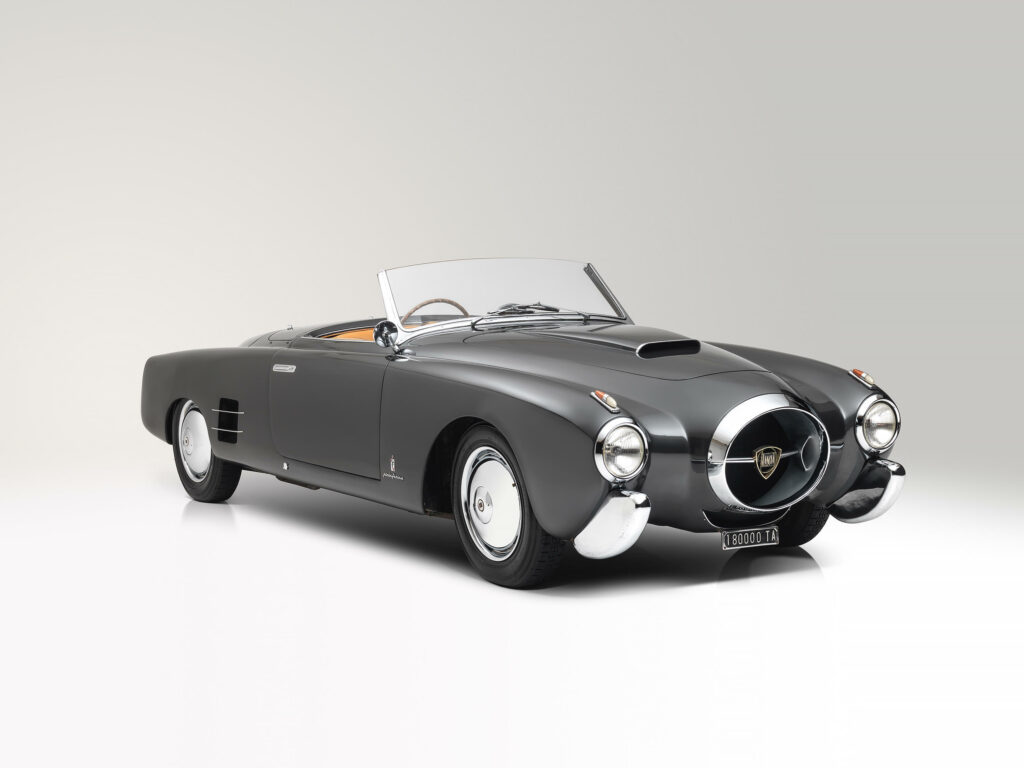
At the Turin Motor Show in spring 1953, a PF 200 spyder was exhibited that differed from the ‘parent’ car of the year before in the front end (bumpers positioned more externally, under the headlights, directional flasher mounted above the mudguards, air-intake grille no longer perfectly round but elliptical in shape and with the outer edge no longer chrome but in body colour) and in the area behind the doors, where one notices the inclusion of the ventilation grille (which had already appeared on the coupé version).
The last version of the PF200 spider appeared in the autumn of 1953, at the Paris motor show; the changes concerned the outer edge of the front air intake-mask – again elliptical in shape – which was now again chrome-plated, the application of deflectors to the doors and finally the abolition of the ventilation grille that had previously been fitted to the side, immediately behind the rear wheels. At the Paris Motor Show in the autumn of 1954, a new version of the PF 200 coupé appeared, differing above all in the rear, where the rear window was recessed into the bodywork. The roof of the car is then joined to the tail by two ‘fins’ that have an albeit tenuous function as directional stabilisers.
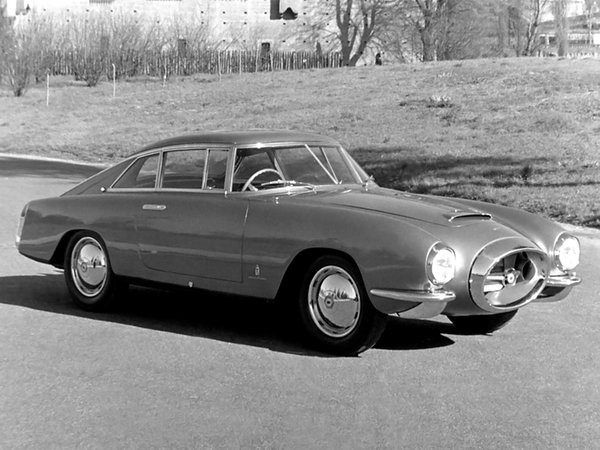
The last PF200 coupé – built on a shortened B55 chassis – was exhibited at the Turin Motor Show in April 1955. It followed the previous models but featured a pavilion cut that ‘anticipated’ what Pininfarina would propose years later on the Ferrari 250 GT coupé 2+2 and the Flavia Coupé.
The PF200s were not built for direct market placement; the intention of the manufacturers (Lancia and Pininfarina) was to have a show car, out of the ordinary, to be exhibited at the various international shows and salons (for advertising-promotional purposes) and to be entered in the numerous concours d’elegance that were very much in vogue at the time, but the car was nevertheless appreciated for its originality by members of the entertainment world, who came forward to take possession of it: one PF200 was certainly bought by the Italian actor and singer Renato Rascel.
The 'Florida' by Pininfarina
The first Florida, a blue and white coupé destined to make history and become a legend, was built on the B56-1002 chassis: it was a fabulous car, with a line that was certainly innovative, even if it was partly influenced by North American trends of the time. The fittings are luxurious and the finish impeccable. Pininfarina’s new creation also introduced the horizontal radiator grille to Lancia: in truth, innovative front grills – abandoning the usual Lancia scheme with the vertical shield – had already appeared on two examples made by Stabilimenti Farina and Boneschi in 1951, but these cars passed almost unnoticed, unlike the Florida, which immediately hit the headlines.
The first example of the Florida series, the coupé, was unveiled at the 1955 Turin Motor Show.
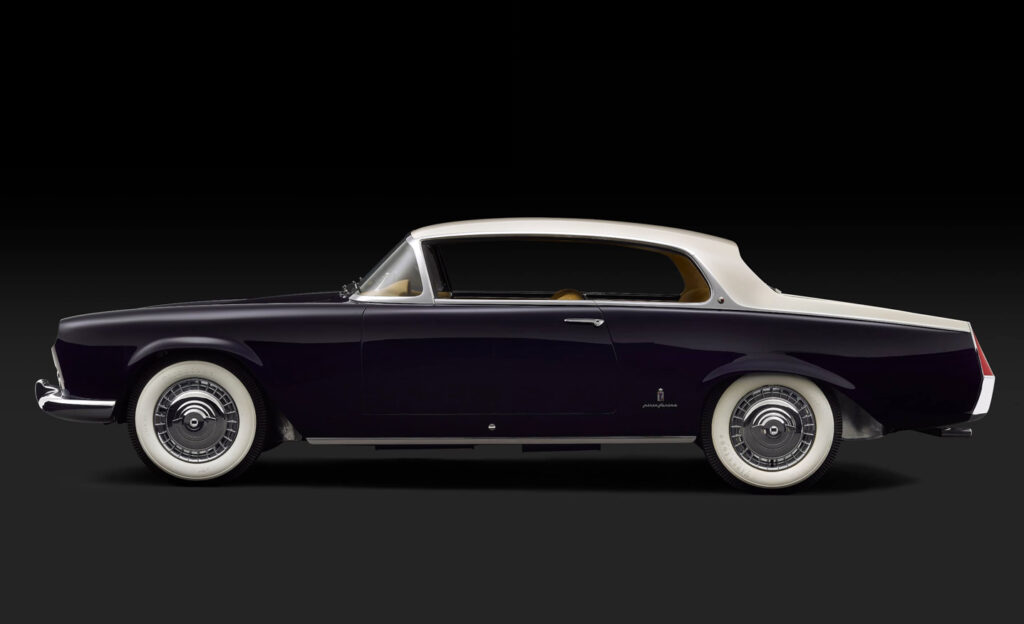
In 1955 two 4-door Florida cars were built on the B56 platform (one probably with chassis B56-1003, the other with chassis B56-1005) plus one on a B56S chassis (i.e. left-hand drive, probably chassis B56S-1006). The ‘4-door’ was shown to the public for the first time at the Paris Salon in autumn of 1955. The last 4-door Florida (with right-hand drive) was displayed at the Geneva motorshow in March 1956. A month later, at the Turin motorshow, the first Flaminia prototype appeared, clearly derived from this last Florida but ‘tamed’ to make it more suitable for mass production. An important structural modification that distinguishes the Flaminia prototype from the Florida lies in the central pillar inserted between the two side doors, a variant that became indispensable to stiffen and reinforce the whole car: torsion problems had already arisen in the first ‘4-door Florida’, so much so that in subsequent cars an attempt was made to partially remedy the problem by inserting a reinforcement bar behind the front seat. On the basis of the data presented so far, the Florida built would be 4, of which 1 two-door, 2 four-door right-hand drive and 1 four-door left-hand drive. It should be added, however, that some sources also speak of a right-hand-drive four-door with chassis B56-1006. Counting this Florida would bring the total to five.
The last of the Florida’s – with an original four-door coupé bodywork, the two rear doors (rather small) made practically invisible by the absence of opening handles – was again the work of Pininfarina, named ‘Florida II’ and displayed to the public for the first time at the Turin motorshow in autumn of 1957. This car – representing the ‘prototype’ of the Flaminia coupé that came out exactly 12 months later – was built on the mechanical basis of the Aurelia with a 2.3-litre engine using a B56S floorpan, probably built in 1956 and lying unused in the factory. One or two Floridas (according to various sources, probably the left-hand drive Florida chassis 1006 and/or the Florida II) were for years the personal cars of Pininfarina (at the time still Battista Farina, known as Pinin, since it was only in 1961 that the surname was changed to Pininfarina, thanks to a decree of the President of the Republic ‘in consideration of the high social and industrial merits’).



